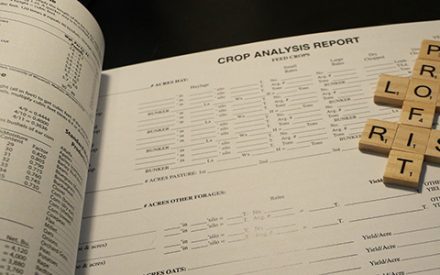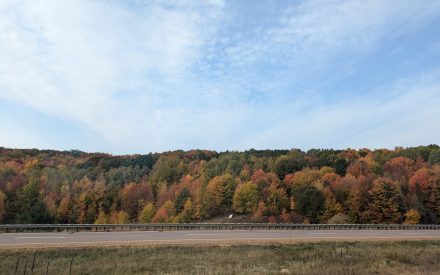Video Summary
In this video, Dr. Harkirat Kaur, assistant professor and extension corn production systems specialist at UW–Madison, explores the agronomic potential of short corn hybrids as an alternative to Brown Midrib (BMR) corn for silage.
With BMR hybrids facing a potential phase-out, this session dives into the challenges of BMR, the benefits of short corn—including improved standability, digestibility, and accessibility—and preliminary research findings from UW–Madison. Learn how short corn could reshape forage strategies and support livestock nutrition in the years ahead.
Resources
- From Dent to Done: Timing Silage Corn Harvest in 2025
- Beyond BMR: Securing the Future of High-Quality Corn Silage
- Extension Crops and Soils Corn Silage page
- Pricing Corn Silage
- Find your Regional Crops Educator
Transcript
0:05
Hi everyone.
0:06
Thank you for being here.
0:08
It’s a beautiful day out there and we are here trying to learn more things and look into how things will be looking like in next few weeks.
0:16
And that was a great weather outlook by Josh and he set us quite into the rhythm.
0:23
And now we’ll be shifting gears a little bit into the news that we have been hearing about BMR phasing out.
0:33
And you know, how will it affect us and what are options going forward?
0:38
It’s, it’s a situation which has a lot of questions.
0:42
We do have some research which can help us answer those questions, but we also have a lot more to explore on.
0:49
So that’s what I’ll be talking about in a bit.
0:52
So as we look for good quality silage corn, we primarily look for something that can give us a higher biomass yield, which is also accompanied with a higher component of digestible fiber and the overall nutrition composition.
1:10
Where we have you know good amount of dry matter, we have good amount of starch and although not as high on the priority, but still we want some good crude protein and all that then encompass into how the livestock will perceive our silage and perform eventually.
1:28
So now when we look at these four different caveats or different 4 scenarios for good quality silage, I like to plot it on a chart where I have dry yield as a quantitative measure on the Y axis and milk per ton as a qualitative measure on the X axis.
1:47
So when we look at this chart and if we divide into four different quadrants, we would normally want our hybrids to perform in a way that they are giving us a high tonnage and high quality because that’s what is profitable for us, that’s what’s good for our livestock.
2:06
There are some scenarios where we get high tonnage, low quality or low tonnage high quality and those scenarios may demand some, you know proportioning of the diet in a way that it is still workable.
2:18
Where we don’t want our corn silage to be is the low tonnage, low quality quadrant.
2:24
So now when all when we envision our silage, the goal is always to be in the fourth upper quadrant and that’s where all the breeding and agronomy efforts come into play.
2:39
And that’s how the BMR is also, you know, what fits into our overall system.
2:45
And the role of the BMR was to actually help us stay in that quadrant by improving the overall quality, but because it had lower lignin content, which then and also, you know, lower fiber content and higher digestible proportion of the overall silage and which amounted to higher milk yields per ton.
3:08
But it also came with few challenges which made it a little shy away from that 4th quadrant.
3:15
And we were having issues and there has been a lot of management research that has, you know, strove to address those challenges, but unfortunately some of them still persist.
3:29
And one of the biggest ones from there is the stalk strength.
3:33
The one of the major problems that we get in the BMR corn is, you know, the stalks are not as steady and stable, which eventually also makes it more susceptible for diseases and insect wounds.
3:48
And that overall also have an effect on its stability in say a torrential rain event or in a windstorm event.
3:58
And that kind of, you know, impacts our overall yield stability.
4:03
So now with the now since BMR hybrids have been in the market for about last 29-30 years, these challenges have still persisted.
4:14
And that’s something which have made the industry to, you know, ponder about this fact that do they want to continue it in a way or do they want to phase it out.
4:25
And at this point, it looks like they are looking towards the phase out part of the solution in comparison to the other one.
4:36
So if we are looking at this phasing out situation, what are our options?
4:41
We look into different options, starting with maybe cutting height variations.
4:49
Why would a cutting height variation solve the problem or increase the digestibility?
4:54
That’s because when you know, normally say we cut our silage somewhere around 5 to 8 inches, but if we increase our cutting height, we’re essentially decreasing the amount of stalk in our feed.
5:09
And stalk is the part of the plan that has highest lignin concentration.
5:14
And that’s how we we may be able to manage the lignin part of the overall plant and increase the overall digestible component of the plant because now the starch or the ear is a bigger percentage of the plant.
5:31
If we look at the plant architecturally, this would also eventually lead to increase in milk per ton.
5:39
But obviously things are not so simple because research shows, and this research is from the corn agronomy lab done by Doctor Joe Lauer, my predecessor.
5:50
And his research shows that as we increase the cutting height, we have been seeing a decline in the yield.
5:59
And if we need to, if we look into it in a more relative term, we can look at this chart on the right here.
6:08
So say at six inches, if we have a silage yield, which is in relative terms 100%, when we are doubling the cutting height, we are losing about 8 percentage, 8% of the overall silage yield, whereas we’re only increasing our milk per ton by 5%.
6:30
So there’s a 3% lag over there and that’s something which does not make this solution as simple as we would like it to be.
6:42
These, this relativity is also reflected in, you know, looking at the numbers of milk per acre.
6:48
And this also comes with challenges in moisture because now the moisture dynamics of the plant is changing, which would eventually lead to problems or challenges while we are packaging it.
6:59
Or, you know, if during fermentation and eventually at the feed out, we may not have as good or as high quality silage as we would like it to be.
7:13
Doubling down on the challenges with cutting height variation.
7:18
Dr.
7:19
Ferraretto’s student, Cole, he had, he had this extension fact sheet and I really like the way, you know, they kind of went all out for extreme harvest height conditions.
7:34
And it was observed that although as expected, the NDFD increased and we saw steep decline in the in the dry matter yields.
7:47
And when we looked at it in with respect to the rate of decline with each inch increase in harvest height, we were increasing our NDFd by .2%.
8:00
But at the same time, we were decreasing our dry matter by .6%, which means that there’s a three times, three times factor that is into play over this, which means it’s not a very viable solution when in terms of increasing the overall digestibility to compete with or to solve the problems that we’re having with BMR.
8:23
But when I think about cutting height variations or increasing the harvest height, we’re essentially decreasing the stalk height.
8:32
So that that accompanied with a lot of conversations that I have had with our extension educators and growers makes me think if the IT if that is something that can be made made possible by the involvement of short corn into the system.
8:53
So because short corn is essentially genetically and selectively bred corn hybrids and it is shorter than the traditional corn by 1/3 or 1/2 of the and of the plant height.
9:10
The the key part over here is that we have smaller internodes.
9:15
So the number of the leaves in short corn and a tall corn plant would roughly be the same.
9:21
So we’re not losing the foliage, but we’re still having, you know, a shorter stalk essentially or smaller internodes.
9:30
However, it does come with its own challenges like the ear will be a lot more closer to the ground.
9:36
So over here I have a figure which kind of shows the progression of short corn.
9:41
And you as you can see and if you have been in Arlington or you know, in some of the short corn research trials, you’ll be able to see that by V8 to V10 is when it starts staggering out.
9:55
And that’s when we kind of can tell that all these plots are for short corn and these are for tall corn.
10:01
And we have been, you know, trying to do research on the plant architecture and also the overall yield measurements for this in order to answer some of these questions.
10:14
So the overall agronomic benefits of short corn were when short corn was bred with the with the mind was that we need an improved stand ability.
10:27
As I said, we need something which is resistant to you know lodging because of torrential rains, because of extreme weather conditions with respect to wind storms, etcetera.
10:39
Because, you know, because after a certain height the corn plant attains, it is very susceptible to these challenges and it results in large percentages of yield losses as well.
10:54
And secondly, we also want a plant architecture which is more nutrient and water use with more nutrient and water use efficiency.
11:05
And obviously, after everything above, we do need an easy accessibility.
11:11
And with Short corn, the idea is that you are able to manage your plants, you manage your fields easily because now you have an easily accessible field for your fungicide applications, for your insecticide applications as well.
11:28
And it’s easier to manage overall.
11:31
So when we look at short corn from the perspective of silage, the intended benefits kind of add on few things and also kind of shifting gears.
11:42
So over here if you say, if you compare it with the variability or increase in cutting height, we can see that we would we are definitely losing less foliage as compared to as compared to increasing the height in the corn, increasing the harvest height and corn silage.
12:04
So over here I have a picture.
12:06
So on the left, the stalk is from a short corn plant and on the right it’s from a tall corn plant.
12:13
And you can see the internode lens differences in the internode lens quite clearly.
12:21
It’s almost half of what we’re seeing over here, half to 1/3 of what we’re seeing over here.
12:30
But now when we think about shorter stalks, it means the overall lignin content may be less than.
12:37
Similarly, we’ll have a year which is now a bigger part of the plant, a bigger percentage of the plant.
12:44
So that means higher starch content, higher digestibility, amounting to higher milk per ton.
12:51
And obviously because these plants are bred to be more sturdier, more stable, they have again that resistance from lodging.
13:02
They have a potential to stand against torrential rains and wind storms as well.
13:09
And beyond everything, we do have easy accessibility for sure.
13:14
So looking at the data from our preliminary trials last year for short corn silage, we did see that the short corn was comparable to tall con hybrids with respect to the dry yield numbers.
13:32
And one thing that I would like to point out over here is that we did see some variability in the yield numbers across the five hybrids that we tested for short corn.
13:44
And the idea behind having these many hybrids in a single trial for for short corn is that we are in still in the screening phase and we’re trying to see what hybrids are performing better under what conditions and what are not.
13:59
So this year we have added different hybrids and screened out some of the ones that didn’t that were not performing up to the the standards or the bars that we set for the overall for the overall crop.
14:17
Looking at the nutritive value, we did see a higher percentage of starch in short corn as compared to BMR as well.
14:28
And some of the hybrids were even performing in a way that we had numbers which were higher than what we were seeing in tall corn for sure.
14:36
And secondly, again over here, if you see the spread of the error bar over here, we were having a lot of variability in what we were seeing among our hybrids.
14:48
The NDFD values, that is the digit that that is the digestibility values were also comparable to what we were seeing in BMR as well.
14:58
So obviously it’s not as high as some of the BMR hybrids get, but it’s still something which gives us a number where we can, you know, we we can, we can play around without losing much of the digest much on the digestibility while still maintaining high yields.
15:22
So as as I was looking through these numbers, I tried and put the comparisons that we were talking about initially on this on this chart to see where does it fit with respect to the silage quadrant.
15:42
And five out of four hybrids from Short corn that we tested last year were on the upper, on the upper left side of the chart and quite you know in the parameter of the perimeter of the high tonnage, high quality region.
16:01
Obviously, as I said, there are weather conditions, there are management strategies that still need to be tested for short corns.
16:11
So there is some variability that we are seeing currently and we hope that by the time short, by the time BMR is being designed to be phased out completely or largely by 2030.
16:25
We have all these answers upfront.
16:28
So our growers can, you know, decide for themselves and have with the unbiased information that they have in front of them.
16:37
Although we still didn’t have anything that was you know anywhere closer to low tonnage, low quality, we did have some which were you know little bit closer to high tonnage, but on the lower side of quality.
16:55
But still most all of the observations that we had largely, largely fell in the fourth top quadrant of silage nutritive value or quality.
17:06
So again, I would like to highlight that why, why did I start looking at short corn in a different way while I was comparing it with the cutting height, It’s primarily because I was, you know, looking at it from a perspective of reducing the overall stalk component of the plant and increasing the digestible component in relative terms.
17:30
I, I would, I won’t say it’s something that that’s happening from, you know, from, from, from within the plant.
17:37
It’s something that we are trying to do it in a way that we are overall help.
17:44
We are overall trying to play with the architecture of the plant in a way that we build its composition.
17:51
So for Short corn we were obviously having higher foliage percentage because now we don’t lose leaves and that would eventually amount to lesser yield penalty.
18:03
However, at this point short corn is still need is still needs to be screened for various diseases.
18:13
You know, be it gray leaf spot, tar spot, Southern rust, the ones which have been which have been increasingly common in our environments for past few seasons.
18:29
And similarly, they need to be, you know, screened for trait packages which protect our plants against corn root worm, western bean cut worm, corn leaf aphids, et cetera.
18:40
There are other unanswered questions at this point with this approach, which would mean that we are looking at various large differences in ear heights and that would mean that there’s some changes required with respect to how do we harvest it, how do we plan, how do we adjust our equipment.
19:02
Secondly, we are trying to, you know, figure out and get answers on optimum row spacing and seating rate scenario while also understanding what’s the rate of dry down and moisture levels in short corn.
19:17
And eventually we’re also trying to see how well will it perform in collaboration with other forages say alfalfa
19:27
And so we have been trying to, you know, keep up with these research efforts over here at UW Madison and also across the state with the help of various collaborators.
19:38
So with that, I would like to sum up by saying that number one, BMR is not disappearing completely.
19:45
And if you would have come across this amazing, amazing extension article put together by some of our extension educators, they they provide, they detail what’s going on and they and it and article explains all the different approaches.
20:05
I over hear was most most focused on short corn and changing the height variations.
20:11
But in that article, you’ll be able to, you know, evaluate and understand a a lot of different approaches and where you can apply those solutions as well.
20:25
For short corn hybrids for silage, they do have better stand ability, they do have improved access, they do have higher digestibility options.
20:37
It’s just a matter of time that we screen the better performing hybrids and we and we give the growers the information on that.
20:47
The the results that I showed today, they look promising, but just a heads up, those are preliminary results.
20:55
We are hoping to see something similar this year as well.
20:59
And hopefully the replicable replicated results is something which will help us understand these systems with more power.
21:09
Beyond that, there are other options with the, you know, high digestibility fiber or dual hybrids when managed with optimum harvest height and seeding rate that can actually help you reduce your losses with respect to digestibility.
21:28
And with that, I would like to do a quick plug and not go over time over here.
21:33
So we have a Badger crop network web page.
21:37
So if if you scan this QR code, it will take you there.
21:41
There are university state specialists over there giving you very regularly updated, very regularly updated information and how to use different tools available through the university system over there.
21:58
It’s been done with collaboration from UW Extension and you’re trying to keep up the work that they have been doing as well.
22:10
And with that, I would like to thank some amazing people and collaborators who helped this research.
22:16
And I would end with another plug for the Crop and Soils Extension website and also open the floor for any questions.
22:30
Thank you.
22:32
Thank you Harkirat for sharing that really exciting work.
Badger Crop Connect
Timely Crop Updates for Wisconsin
Second and fourth Thursdays 12:30 – 1:30 p.m.
Live via Zoom

 ▶ Fall 2025 Financial Assistance for Producers
▶ Fall 2025 Financial Assistance for Producers ▶ Fall 2025 Ag Policy Update
▶ Fall 2025 Ag Policy Update ▶ Fall 2025 Corn and Soybean Market Outlook
▶ Fall 2025 Corn and Soybean Market Outlook ▶ November 6 Ag Weather Outlook for Wisconsin
▶ November 6 Ag Weather Outlook for Wisconsin


